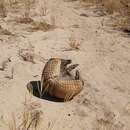mk
имиња во трошки


Found in parts of the northern highlands of Brazil, including the western part of the province of Bahia, Pernambuco, Piauí, Maranhão, and northern Minas Gerais, the Brazilian three-banded armadillo (Tolypeutes tricinctus) has a head and body length of 218 to 273 mm (8.6 to 10.7 in), a tail length of 60 to 80 mm (2.4 to 3.1 in), and weight from 1.00 to 1.59 kg (2.2 to 3.5 lbs).
Three-banded armadillos are blackish brown in color. Most animals have three moveable bands, although some possess only two, and others may have four. Members of the genus Tolypeutes are the only armadillos that can completely enclose themselves in their own shell by rolling into a ball. The large front and rear portions of the shell are not attached to the skin on the sides, providing ample free space to fit the head, legs and tail into the shell when the animals are rolled up.
The 2nd, 3rd and 4th toes of the hind foot are grown together, almost like a hoof. The 1st and 5th toes remain separate. T. tricinctus has five on the fore foot. The claws on the forefeet are very strong. Three-banded armadillos generally walk on the tips of the foreclaws, even when running. The tail is short and thick. The diploid number of chromosomes is 2n=38, the lowest of any armadillo studied to date — most other armadillos have 2n=50 to 64. (Humans have a diploid chromosome number of 2n=48, for comparison.)
T. tricinctuslives in tropical forests on chalky grounds, and in the Caatinga and Cerrado of Brazil.
When threatened, members of the genusTolypeutesroll up into ball, leaving only a small opening between the shell edges. If the animal is prodded through the opening, it quickly snaps fully shut like a steel trap. Rolling into a ball appears to be an effective defense against natural enemies.
Three-banded armadillos principally eat beetle larvae, although ants and termites are an important portion of the diet during the dry season (July to November). Insects are obtained by burrowing into ground nests or under the bark of rotting trees. The animals also include a significant amount of fruit in their diet during the wet season.
Three-banded armadillos may be found at densities of up to 7 animals per square kilometer. They are primarily solitary, although groups of up to 12 have been observed sharing the same den site during cold spells.
One young is born per litter; gestation period is about 120 days. Litters are generally born between November and January. The young are born fully formed, resembling miniature adults, and can walk and roll into a ball immediately from birth. Young are weaned at 72 days, and are sexually mature at 9 — 12 months. The IUCN classifiesT. tricinctusas vulnerable.T. tricinctusis threatened by habitat destruction. Both species ofTolypeutesseem to be suffering due to overhunting.